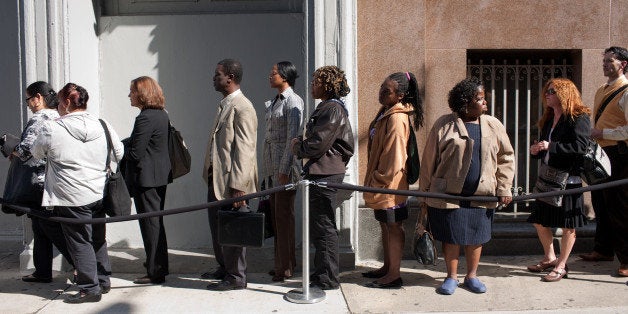
This article has been co-written with Melissa Fichera, an economics major at Siena College.
This June marks the five year anniversary of the official end of the Great Recession. Stock prices and corporate profits have surpassed their pre-recession peaks and the unemployment rate has fallen from 10 percent to 6.3 percent. Many Americans, however, are not feeling the fruits of this growth. In fact, 57 percent of Americans still believe the economy is in a recession. Why does a majority of the population believe this, despite five years of economic expansion?
Unlike professional economists, who measure recessions and recoveries according to technical, data-driven criteria, most Americans base their assessment on their own personal economic situation, as well as that of their peers. Since only 10 percent of the population owns 90 percent of all stocks, the recent bull market has improved economic conditions for only the wealthy. The two indicators that primarily affect the living standards of the majority of Americans -- jobs and wages -- have improved at a significantly slower pace. While unemployment has fallen, many of the new jobs are low-wage, low-skill positions. Wage growth for the average American has hovered around 2 percent per year, barely keeping pace with inflation. Living standards, especially for young Americans, are worse than any point in recent history.
Yet there have been more alarming, and hidden, developments in the labor market that suggest the U.S. economy has yet to fully recover from the recession. Our research on the monetary cost of job loss provides greater insight to what Americans are actually experiencing because it paints a broader and more accurate picture of the health of the labor market. We define the cost of job loss as the total weekly amount of income a worker loses following the loss of their job. When someone becomes unemployed, their employment income is replaced by unemployment insurance, food stamps and other income-support programs, which cover approximately 35 percent of their previous employment income. The longer a worker is unemployed, the longer they must rely on income-support programs and the longer they are "earning" lower income relative to what they would be earning if they were to be reemployed.
We find that during the recovery from the Great Recession, the average worker can expect to lose 50 percent (approximately $458) of their previous weekly employment income when they experience job loss, double the historical average. During the recession itself -- December 2007 to June 2009 -- workers were only losing 36 percent of their employment income. In other words, the financial cost of losing a job has actually risen during all five years of the economic expansion. This is the highest level for the cost of job loss since the Great Depression. The record rise has been driven by high and rising unemployment duration.
Those who lose their jobs can now expect to remain unemployed for over 35 weeks, double the historical average. In the face of rising long-term unemployment, politicians have reduced funding for food stamps and extended unemployment insurance, making longer bouts of unemployment even more trying. This reduction also creates insecurity for the employed, for they know if they lose their job, a harsh, costly bout of unemployment awaits them.
The main effect of the record high cost of job loss is that it will depress the economy's growth rate by reducing consumption. Unemployed workers, with their limited means and stringent financial constraints, will reduce their already-low consumption level. But as employed workers see the cost of job loss rise, they, too, will decrease their consumption in an attempt to create a financial cushion by increasing their savings. As people consume less, firms don't have the resources to increase wages or hire new workers, keeping unemployment and unemployment duration elevated, further increasing the cost of job loss.
This vicious cycle explains why the recovery from the Great Recession should be called the Great Stagnation. Without concerted policy action, the U.S. economy is doomed to remain stagnant for years to come. The economy might be plateauing at a new normal, one defined by low output, employment and wage growth. This new normal will likely see unemployed workers experiencing high costs of job loss, even during economic expansions.
The most effective short-run policy to combat this possibility is to increase unemployment insurance and social welfare programs for the unemployed. This, however, is doubtful if Congress is swayed by those like Rand Paul, who argue that unemployment insurance acts as a disincentive to finding a job, despite economic evidence suggesting the opposite. Rather, the biggest issue in preventing workers from finding a job is that job opportunities are significantly weaker than previously, causing many jobless workers to drop out, or never enter, the labor force. The conventional measure of the unemployment rate does not include these "missing workers." For if it did, the unemployment rate would be over 10 percent.
But income-support for the unemployed is only a temporary fix. We must find ways to ward off the coming Great Stagnation. To regain pre-recession labor market conditions in 2 years, the pace of job growth would need rise from 180,000 to 400,000 jobs per month. To accomplish this, Congress must implement aggressive policies that stimulate the economy, such as increased investment in infrastructure or by directly creating jobs for unemployed workers.
With a record high cost of job loss burdening unemployed workers and creating fear among employed workers, it is no surprise that 57 percent of Americans think we are still in a recession. Slow job growth and even slower wage growth has helped paint a recessionary picture for many Americans. The richest 1 percent of the population has captured 93 percent of all of the income gains since the recession ended, so the recovery has not been felt by the majority of the population. Though we might not be in a recession, the U.S. economy faces a bigger threat: that we are at the beginning of the Great Stagnation.
